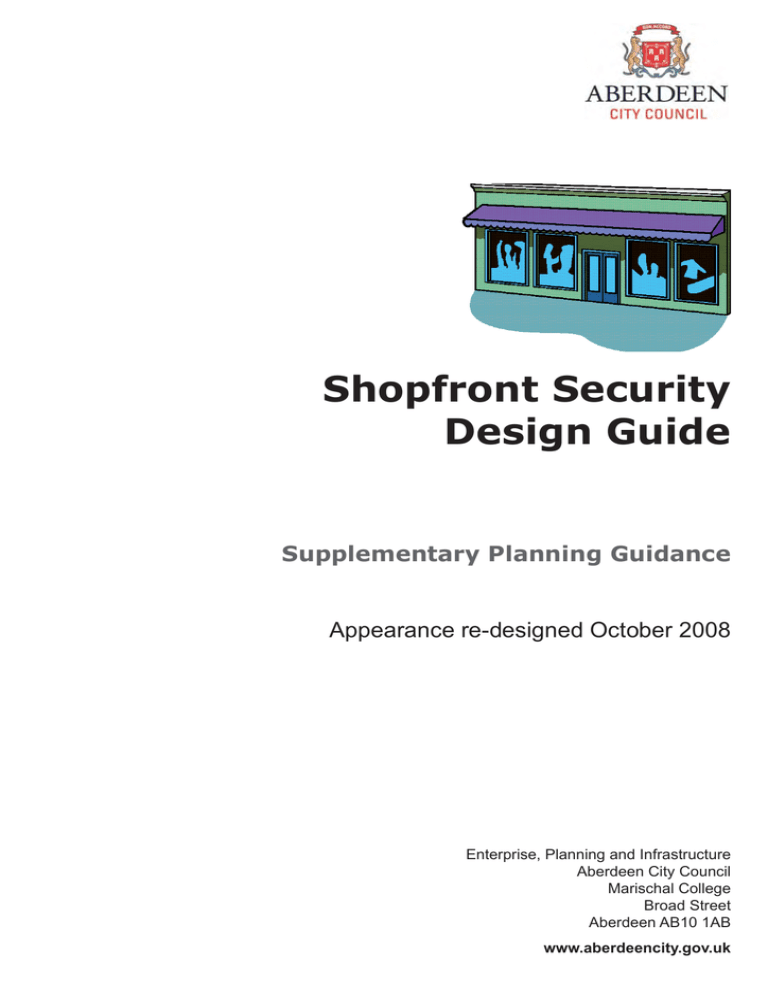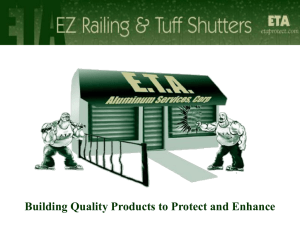Shopfront Security Design Guide
advertisement

Shopfront Security Design Guide Supplementary Planning Guidance Appearance re-designed October 2008 Enterprise, Planning and Infrastructure Aberdeen City Council Marischal College Broad Street Aberdeen AB10 1AB www.aberdeencity.gov.uk www.aberdeencity.gov.uk/planning INTRODUCTION CONSIDERATIONS The current policy guidelines for roller shutter blinds on shop premises were approved in 1987 and were subsequently adopted as part of the 1991 Local Plan. The need for planning permission and listed building consent no presumption in favour of external roller shutters Planning permission is required for the installation of roller shutters and demountable grilles on shopfronts in so far as the external appearance of a building is almost always materially affected. Listed Building Consent is also required where such proposals affect the character of a building which is recognised as being of special architectural or historic interest. This is the case irrespective of whether roller shutters are of a solid or open mesh type, are mounted externally or internally, or are erected to screen windows or doors. increased management in relation to adopted Conservation Areas/Listed Buildings The development plan distinction between adopted Conservation Areas and those identified in the Local Plan In considering the matter of security of shop premises, the council apply adopted policy guidelines for development management purposes. The guidelines provide the basis for development management decision taking for shopfront security. The amended policy guidelines are: clarification of the terms ‘grille’ and ‘shutter’ increased management in primary shopping streets and along the main approach roads to the City reduced management elsewhere in the City in certain situations CORE VALUES The council will strive to enhance the high quality of life within the City as this value relates to balancing the need for shopfront security measures, to ensure the continued viability of retail premises with the need to conserve the City’s built environment, avoid visual intrusion and encourage a secure and amenable street scene. Shopfront security measures required to counter problems of vandalism and theft when shops are closed are often at variance with Local Plan policies, in particular: the expectation that development preserves and enhances the character of Conservation Areas/listed buildings the presumption against development which adversely affects the amenity of the main approaches into the City by road and rail the presumption in favour of proposals which enhance the vitality of existing fringe, linear, local and district shopping centres the presumption in favour of protecting the amenity of residential areas Shopfront Security Guide Page 2 www.aberdeencity.gov.uk/planning The need for a review of established policy guidelines Operation of the policy guidelines through development management has highlighted an inconsistency of decision making and application of the policy in practice. In particular, the approval of a number of planning applications for the installation of roller shutters in peripheral housing estates contrary to the adopted guidelines and contrary to recommendation for refusal has indicated a desire by the Committee to relax the standards in certain instances. Furthermore, it is found that the guidelines are not explicit enough to provide a sufficient degree of management in relation to Conservation Areas and listed buildings. For example, they imply that the erection of externally mounted roller shutters on original shopfronts, which could adversely affect their character, may be acceptable. The distinction between shutter and grilles Historically, the terms ‘grille’ and ‘shutter’ both relate to demountable, rigid structures rather than modern roller type installations, with a key distinction being that ‘grilles’ were of open, often decorative form, whereas shutters were solid. A degree of ambiguity has arisen, however, because both terms are now used to also refer to roller type installations which are not of a rigid, demountable type, and the terms are sometimes used synonymously. Although the term grille tends to be used to refer to structures with a high degree of openness, it is also sometimes used to refer to screens which are visually solid. The term shutter is used to apply to both open and solid structures. This can create confusion and delay in the processing of applications. The adoption of the following definitions is therefore considered appropriate in the interests of consistency: demountable grille - a rigid open lattice, grating, mesh or screen constructed of metal open mesh shutter - a roller shutter with a significant degree of openness in its laths, so that the density of the laths does not obscure the window display or prevent visibility into the shop solid shutter - a rigid or roller shutter with laths which obscure the window display and prevent visibility into the shop Demountable grilles are generally less obtrusive, and a more reversible alteration to a shopfront as no box housing or runner guides are required and the grille itself is less visible and more open than a roller shutter A key difference between these shutters as well as physical appearance is visibility in terms of the amount of light allowed to pass through the shutter to permit window shopping, allowance of surveillance of the shop from the street and spillage of light from the shopfront onto the pavement. Whilst solid shutters are particularly obtrusive, other types of shutter may produce a similar aesthetic result [eg some perforated and punched laths with small holes]. These should be considered to be ‘solid’ in policy terms. In instances where more than 70% of the surface area of the shutter above stall riser level [if any] consists of solid sections, these shutters should also be regarded as being of the solid type. Where there is no stallriser, this percentage should be measured from 800mm above external ground level. Where 50% or more of the surface area of the open/punched section of the shutter is actually solid, the shutter shall be regarded as being of a solid type. The security differences between open and solid shutters Whilst solid roller shutters are most effective in resisting direct criminal attack, they have a number of drawbacks: it is not possible to see if anything untoward is happening inside the shop. Where illegal entry may have been gained, other than through the shopfront, the thieves can continue unobserved where a significant number of shopfronts have been fitted with solid shutters, and especially when they are of an untreated finish, it conveys a message that the area is vulnerable to crime. Not only is this an important indicator to the criminal, it also discourages the general public from entering such areas and thus the benefits of passive surveillance are lost would-be customers cannot window shop outside business hours. This can have a detrimental effect on trade at a time when the retailers are fighting hard to increase custom Shopfront Security Guide Page 3 www.aberdeencity.gov.uk/planning solid shutters also provide a blank surface for graffiti which additionally conveys a message that the area is vulnerable to crime Although open mesh shutters can be pulled off the shopfront by passing ropes through the slots special features can be incorporated in the shutter to avoid this, and solid shutters can also be pulled off. The main security advantage of solid shutters over open mesh types is not in practice protection against burglary, but prevention of vandalism as shutters prevent damage to the shopfront itself. To overcome these problems, aluminium punched lath shutters can be adapted to include a clear polycarbonate infill strip behind the shutter. Such a shutter offers security benefits and protection against vandalism and would be appropriate for use in situations where solid shutters would otherwise be used. The viability of alternative security measures Many shops exist without using shutters/ grilles on their shopfronts, thereby indicating that security is not a major problem that threatens their viability. In most situations, laminated glass combined with some form of internal open mesh grille, either demountable or of a roller type, will provide adequate protection against theft. Externally demountable iron grilles which are usually placed over the lower part of the display window and doors and painted black, are a more traditional form of protection than roller shutters and are particularly suited to traditional shopfronts with recessed doorways where loitering of people in the recess could pose a security problem and installation of a roller shutter would adversely affect the traditional appearance of the shopfront. Such arrangements do not, however, provide total protection against vandalism to the shopfront, hence externally mounted solid roller shutters are often preferred by shopkeepers. Roller shutters are also more convenient as they are easier to operate and store than demountable grilles. Shopfronts within peripheral housing estates and in isolated areas, away from primary shopping streets and surrounding residential properties, where there is less natural surveillance, tend to experience a greater vandalism problem and are often less architecturally important than the City Centre and Conservation Areas. Often applicants support their proposals for solid roller shutters by claiming that their insurers have insisted on such security measures as a prerequisite for continuation of insurance cover and indicating that, without protection of their shopfront from vandalism, the continuation of their operations would be compromised. Evidence from recent appeals indicates that such arguments are not given great weight and should not outweigh the planning considerations. There may, however, be situations where it is considered that the amenity of an area would not be adversely affected by solid shutters and where the viability of retaining a retail unit is of greater importance. Proposed shutters may also often have the support of Grampian Police. However, it is rare for the Police to advise that a solid shutter would be the only viable security measure. Greater consideration should therefore be given to the degree/nature of risk involved and the quality of the site and its environs. Identification of high risk areas Grampian Police do not consider it appropriate to identify specific areas which are a high security risk as they comment on each proposal and place significant weight on the contents of the premises and the period of its occupancy. These factors are largely outwith the control of the planning authority when considering roller shutter applications, and may vary significantly over time. Other, more physical factors which help to identify the security risk of a premises are: the degree of natural surveillance provided. Shops overlooked by surrounding residential properties and visible from adjacent roads, especially those which are more heavily trafficked, should be at less risk, as should those where there is significant pedestrian movement outwith opening hours, eg in the City Centre whether the premises forms part of a single storey building, with no residential property directly above, opposite or adjacent. Such premises tend to be associated with shopping centres located in the suburbs Shopfront Security Guide Page 4 www.aberdeencity.gov.uk/planning the existence of solid roller shutters, vandalism/graffiti and boarded-up/vacant shopfronts in the area. These are all indicators of a crime risk, whether it be perceived or real, and again tend to be associated with peripheral shopping centres in housing estates, and areas of multiple deprivation The quality of the site’s environs Although the existing policy guidelines do distinguish between Conservation Areas and other areas of the City, by indicating a blanket presumption against solid shutters except where there is no viable alternative, it is not considered that the environment of the site is given sufficient consideration. The importance of preserving and enhancing the character and setting of Conservation Areas and Listed Buildings is of greater importance than the protection provided by solid shutters. In Conservation Areas, there tends to be a greater appreciation and respect for the surroundings. Historic Scotland’s Memorandum of Guidance on Listed Buildings and Conservation Areas advises in relation to shopfront security that: ‘Externally mounted roller security shutters are a major disfigurement which greatly diminishes the character and appearance of any building and should not be given consent: alternatives, such as removable external grilles or ‘brickbond’ internal shutters, should be considered.’ More stringent management is considered necessary within designated Conservation Areas and in relation to Listed Building. Local Plan policy requires development proposals to preserve and enhance the character of these areas, and a greater degree of management over development exists here in comparison to other areas of the City. A general presumption against all externally mounted roller shutters would be more appropriate in designated Conservation Areas and for listed buildings, except in exceptional circumstances, eg where the building does not contribute to the character of the area and roller shutters would not detrimentally affect that character. As part of ‘proposed’ Conservation Areas, have not yet been formally designated and include areas which are not subject to Article 4 Directions [which enable a greater degree of control over development] it is not considered appropriate to apply equally stringent management as within the protected areas. It is, however, considered important to apply a greater degree of management within these areas than within other parts of the City because they have been identified as being of special character. Similarly, it is considered important to distinguish primary shopping streets and the main approach roads to the City from other areas as, within the former: there is generally a higher concentration of pedestrians and levels of surveillance than in more peripheral shopping centres the issue of window shopping is of greater importance than in local shopping centres Within the latter: there is a high degree of surveillance from passing traffic protection of amenity is especially important Within the remainder of the City, the importance of preserving/enhancing amenity is of relatively less significance, although these areas may include traditional shopfronts of character. In some post-war peripheral housing estates where environmental standards are generally not as high as in the older parts of Aberdeen, the need to maintain the viability of a shop which serves a local need may mean that solid shutters would be appropriate, and that the environment of the area would not be significantly compromised. The competency/appropriateness of conditions The Scottish Executive advises that conditions on the granting of planning permission should not be imposed unless they are both necessary and effective, and do not place unjustifiable burdens on the applicant. A condition which sought to control the operating hours of a shop where only a roller shutter is proposed would not therefore be reasonable, however it would be appropriate to impose a condition specifying that during normal trading or operational hours, the shutter should not be kept in a closed position. Permissions ensuring for the benefit of the applicant only are not considered appropriate because planning management are concerned with the use of land rather than Shopfront Security Guide Page 5 www.aberdeencity.gov.uk/planning the identity of the user, ie if a security threat is evident under one owner, it is unlikely that a change in owner would reduce this threat. The use of conditions to manage the design of the proposal, eg specifying that the shutter be painted in accordance with a scheme to be approved by the planning authority would be appropriate provided the circumstances justify it. Consultations The Architectural Liaison Officer of Grampian Police was consulted informally as were the Planning Departments of other major Scottish Cities. Recommendations In considering the matter of security of shop premises, It is recommended that the council adopt the following amended guidelines for development control purposes: There shall be a district-wide presumption in favour of security measures that comprise the installation of toughened or laminated glass internally mounted open mesh demountable/collapsible grilles, or internally mounted roller shutters of a ‘brick bond’ type design externally mounted demountable grilles [not roller shutters] a combination of these Internally mounted roller shutters should not: have box housings visible externally [ie which project below the fascia, or involve increasing the depth of the fascia, or the creation of a sub-fascia] interfere with internal features of interest, in case of listed buildings be of a solid type within adopted conservation areas and in relation to listed buildings there shall be a presumption against the installation of all externally mounted roller shutters, except where the building/shopfront does not contribute to the character of the conservation area/listed building and such character would not be detrimentally affected by such shutters. In the case, externally mounted open mesh roller shutters may be acceptable provided that the box housing is concealed behind the fascia or the extent to which it projects from the face of the building, and does not result in increasing its depth or the creation of a sub-fascia within proposed conservation areas, as defined in the adopted local plan, primary shopping streets and along main approach roads to the City Centre, a similar policy shall apply as in [ii] except that externally mounted open mesh roller shutters shall be acceptable, provided that a shopfront of traditional character is not adversely affected roller shutters may have box housings positioned beneath the soffit of the fascia provided that the box housing is concealed by obscure glass and does not project forward of the fascia for the remainder of the city, except where closely opposed by principal residential elevations, a similar policy presumption as in [iii] above shall apply, except that externally or internally mounted solid roller shutters may be acceptable, [provided that the shopfront is not of traditional character], where there is no viable alternative and the shutters are of an appropriate colour the box housing of the roller shutter may project forward of the shop frontage only in situations where all the following criteria are met the site forms part of a single storey building, or modern building which is not of special architectural value Shopfront Security Guide Page 6 www.aberdeencity.gov.uk/planning the box housing is located immediately below an existing permanent canopy of solid construction which extends laterally to adjoining premises beyond the confines of the site [ie not a traditional style retractable cloth awning or modern style fixed canopy above a single shopfront] the box housing is screened by fascia signage and is located so that the depth of the fascia is not increased it is not structurally feasible to install the roller shutter box housing so that it does not project forward of the façade of the building without creating a sub-fascia it will normally be a condition of any grant of planning permission that during normal trading/operational hours, the grille/shutter shall not be mounted on the shopfront/ kept in a closed position. An additional condition that the grille/shutter shall be of a colour/finish to be agreed in writing by the planning authority may also be appropriate where roller shutters have already been installed, and enforcement action is no longer competent, the opportunity will be taken when, for example, future reconstruction or refurbishment of the premises is proposed, to encourage the installation of security measures which respect the terms of these policy guidelines Appendix 1 Existing policy guidelines relating to roller shutter blinds on shop premises There shall be a presumption in favour of security measure that involve the installation of toughened or laminated glass internally mounted open mesh grille shutters external open mesh grille shutters or a combination of these The roller shutter box housing shall be recessed behind the main frontage of the property and shall not project forward to the fascia. Within Conservation Areas the installation of this housing shall not involve either increasing the depth of the fascia or altering the traditional proportions of the windows. In all order areas every attempt should be made to avoid increasing the depth of the fascia to conceal the box housing It will normally be a condition of any grant of planning permission that during normal trading or operational hours the shutter shall not be kept in a closed position There shall be a presumption against the installation of solid screen shutters within Conservation Areas. For the remainder of the City a similar presumption will apply except where, following consultation with the Chief Constable, the planning authority is convinced that there is no viable alternative to the installation of such shutters particularly in those parts of the City which have been designated as ‘high risk’ areas Where solid screen shutters have already been installed and enforcement action is no longer competent, the opportunity will be taken when, for example, future reconstruction or refurbishment of the premises is proposed to encourage the installation of a security screen which respects with the terms of these policy guidelines Shopfront Security Guide Page 7 www.aberdeencity.gov.uk/planning FURTHER INFORMATION For more detailed information please contact us: Development Management Team Enterprise, Planning and Infrastructure Aberdeen City Council Marischal College Broad Street Aberdeen AB10 1AB Telephone: 01224 523470 Fax: 01224 523180 E-Mail: pi@aberdeen.gov.uk Shopfront Security Guide Page 8





